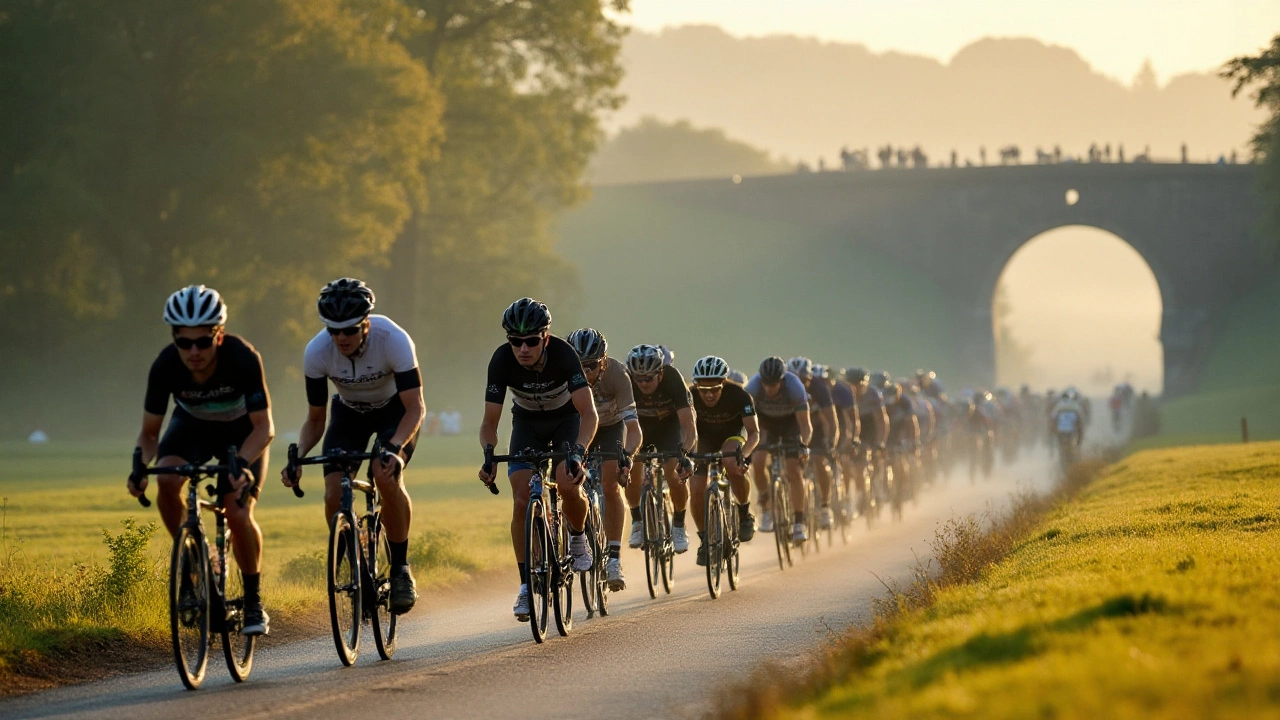Discovering If a Bicycle Qualifies as Sports Equipment
 Nov, 27 2024
Nov, 27 2024
Is a bicycle just a vehicle for getting around, or does it deserve to be classified as sports equipment? It's an interesting topic that many cycling enthusiasts and sports lovers have pondered. While the first encounter with a bicycle might have been a bit wobbly, for most, it quickly becomes a beloved fixture in life, serving purposes beyond mere transportation.
Bicycles can be found in a variety of sports, from road racing to intense mountain biking, each requiring specific skills and technical know-how. They have a rich history dating back to the early 19th century, when they first emerged in an era of innovation. Over time, they evolved, influencing both lifestyle and the world of sports in profound ways.
In this piece, we'll delve into the dual identity of bicycles as both a mode of transport and quintessential sports equipment. We'll discuss different types of bike-related sports, the evolving technology behind these pedal-powered machines, and how cycling can contribute significantly to your health and fitness. So, whether you are a veteran rider or someone considering cycling as a sport, this exploration might offer new insights into the world of bicycles.
- The Multifaceted Role of Bicycles
- Historical Evolution and Usage
- Types of Bike Sports
- Technical Aspects of Sports Bicycles
- Health and Fitness Benefits of Cycling
The Multifaceted Role of Bicycles
When we think about bikes, the first image that often pops into our minds is a simple yet powerful tool for commuting. Yet, their role in society extends far beyond being just a vehicle. Bicycles have woven themselves into the very fabric of sports and fitness, offering a versatile platform for competition as well as personal well-being. It's fascinating how these two-wheeled machines, which might appear rudimentary at a glance, can pivot seamlessly between utility and sport. This multifunctionality stems not only from the design of the bicycle but also from the way people have adopted it for various purposes throughout history. From leisurely rides in the park to grueling races in the Tour de France, bicycles cater to a wide range of activities and skill levels. Indeed, differentiating bicycles as sports equipment becomes necessary when considering organized competitive events like track cycling, cyclocross, and BMX racing, each relying heavily on specialized bicycles and techniques.
The historical trajectory of the bicycle reveals it as not just a tool of enhancement in personal fitness but also an emblem of innovation. Throughout the 1800s, bicycles were a symbol of technological advancement and personal freedom. They offered women unprecedented mobility during a time of social reform, essentially acting as tools of empowerment. Fast forward to today, and bikes stand as a testament to adaptability, having evolved to meet specific sporting needs. The use of specialized materials and design engineering has resulted in bikes that are lighter, stronger, and faster than ever before, pointing to their indispensable role in sports. One interesting fact is that the bicycle industry is valued at billions of dollars globally, which underscores its significance not just as a means of transport, but as a valuable sporting commodity. Various competitive events would be impossible without the modern bicycle, signifying its vital contribution to sports.
The late John F. Kennedy once remarked, "Nothing compares to the simple pleasure of riding a bike." This statement captures the bicycle's enduring charm and its universal appeal.
Exploring the cycling landscape, one notices that bicycles are critical in professional sports. Events like the Olympics or the UCI World Championships would lose much of their sheen without the high-speed excitement brought on by competitive biking. This is where bicycles truly shine as sophisticated sports equipment. Consider the advancements made in competitive cycling gear, where aerodynamics and weight reduction are paramount. Carbon fiber frames, electronic gear shifters, and advanced braking systems all point toward bikes being engineered to squeeze every ounce of performance in the sporting arena. Moreover, the diversity of cycling sports—from mountain biking and road racing to time trials and cyclocross—demands bikes that are not only robust but are also tailored for specific environments and challenges.
Not to be overlooked is the cultural impact bikes have had on communities. Take Sydney, for instance, where the cycling culture has burgeoned, illuminated by public bike lanes and shared cycling programs. These initiatives highlight how bicycles serve dual roles, fostering healthier lifestyles and simultaneously encouraging environmentally conscious urban planning. By catering to both recreational and sport-related activities, bicycles exhibit a span of utility that few sports equipment can match. The role of a bike transforms yet again when used for enhancing personal fitness. Riding a bicycle offers cardiovascular benefits comparable to other forms of exercise and does so with minimal stress on joints, making it an ideal choice for both younger and older fitness enthusiasts. Given their multifaceted nature, it's little wonder that bicycles continue to captivate and inspire generations worldwide.
Historical Evolution and Usage
The bicycle has journeyed through time as not just a means of transport but as a remarkable piece of sports equipment. Its origins can be traced back to the early 1800s, marking it as an invention born from the fervent creativity of the Industrial Revolution. The first prototype, known as the “Draisine” or running machine, was created by Baron Karl von Drais in 1817. This wooden contraption allowed riders to propel themselves forward using their feet, marking the beginning of the bicycle's fascinating evolution. As it captured the public's imagination, inventors around the globe began refining its design. By the 1860s, pedals were added, creating the “Velocipede,” known for its bone-jarring ride over cobblestone streets. This period paved the way for the “Penny Farthing” with its notoriously large front wheel, a symbol of Victorian innovation.
The progression of the bike into the 20th century involved significant technological advances. With the advent of the safety bicycle featuring equal-sized wheels and a chain drive, cycling became more accessible to the masses. By the 1890s, biking was not only a mode of transport and a part of daily life but had slowly started making its way into the realm of sports. Cycling clubs sprouted across Europe and America, hosting the earliest organized races which gained significant popularity. This shift was incredible as it propelled the cycling culture into a new era, making cycling an established spot in the sporting arena. As the years rolled by, bicycles diversified into different categories such as road, mountain, and hybrid bikes, each serving specific sports purposes.
Today’s bicycles owe much to these historical developments as they embody a perfect blend of engineering and elegance. Each development in bicycle technology was matched by an increasing interest in cycling as competitive sports. The Tour de France, probably the most famous cycling race established in 1903, symbolized the sport's growing significance. It's thrilling to witness how early versions of the bicycle laid the groundwork for such grand sporting events. The evolution didn't stop there. Biking became part of the Olympic Games, and the mountain biking craze opened new vistas in the 1970s. Each change emphasized cycling’s adaptability, making the bicycle not just a vehicle but a vital component in various sporting events worldwide, underlining its dual nature as both a tool for exercise and fitness as well as a crucial element in sports history.

Types of Bike Sports
The world of cycling offers a dazzling array of choices, each with its unique thrills and challenges. When you think about bike sports, images of the Tour de France or adrenaline-packed mountain trails might come to mind, but the world of bike sports is vastly diverse, catering to various tastes and skill levels. The most popular and traditional form is road cycling, where athletes push the limits on local streets or compete in grand tours. This sport is not just about speed; it requires strategy, endurance, and a deep understanding of one's own body mechanics. Road races can vary from criteriums, which are fast-paced with numerous laps around short circuits, to stage races that last several days or even weeks, over long and challenging distances.
On the other hand, mountain biking takes the sport off the beaten path. It's a sport that calls for rugged exploration on rough terrains. There are different variations to suit different thrill levels, including cross-country, downhill, and freeride, each with its distinct flavor. Cross-country demands endurance and speed over a variety of terrains, including steep climbs and technical descents. Downhill biking is more about precision and the art of navigation through complex, high-speed descents.
"Mountain biking is not just a sport; it's a profound communion with nature," as stated by Gary Fisher, one of the pioneers of the sport.
If you're drawn to the competitive side, cycling sports have plenty to offer beyond these traditional formats. Consider BMX racing, where riders compete on a specially designed dirt track with jumps, banked turns, and obstacles. This sport, which became an Olympic event in 2008, tests riders' agility, speed, and timing as they perform impressive feats over short but intense courses. Then there's cyclo-cross—a unique cycle sport that blends road racing and mountain biking elements. Here, competitors race over various terrains, including grass, mud, and sand, often needing to dismount and carry their bikes over impassable obstacles. It's a spectacle of agility, strength, and endurance, typically held in autumn and winter, adding an atmospheric battle between man, machine, and the elements.
For those who look for stamina and mental fortitude, long-distance endurance races like randonneuring or audaxes are challenging yet rewarding. These events aren’t traditional races but are more about completing long circuits within a specified period, allowing cyclists to experience the joy of long rides while building mental and physical resilience. Meanwhile, track cycling offers a high-speed and highly technical competition within the confines of a velodrome. Events like the sprint, team pursuit, and keirin emphasize not only speed but also tactics and precise control.
To explore the more artistic side of bike sports, cycling doesn't fall behind either. Events like artistic cycling allow riders to demonstrate incredible coordination and creativity, much like gymnastics on a bike. Then, there are cycling disciplines like bike polo and trials riding, where cyclists showcase their skill sets in handling bikes in less conventional but equally captivating forms, proving bikes aren’t just about racing but are versatile sports equipment capable of endless possibilities.
Finally, the popularity of electric bikes or e-bikes in sport can't be overlooked. These offer both seasoned cyclists and newcomers the chance to enjoy longer rides and tackle tougher terrains with a little assistance, making sports cycling more accessible to a wider audience. With their growing integration into competitive events, e-bikes are reshaping the cycling landscape, bridging the gap between traditional power-driven modes and newer, tech-enhanced experiences.
Technical Aspects of Sports Bicycles
When you get into the nitty-gritty of what makes a bicycle suitable for sports, you delve into a realm of innovation and precision engineering. It's fascinating how each part of a sports bicycle, from the frame to the tires, is optimized for specific functions in cycling disciplines. Take, for instance, the frame material. Carbon fiber is incredibly popular in road racing bikes due to its lightweight nature and superior strength, which allows competitive cyclists to achieve faster speeds. However, in mountain biking, where durability takes precedence, aluminum or even titanium frames offer greater resilience against the rugged terrains.
The design and shape of the bicycle also contribute significantly to its performance. Aerodynamics plays a crucial role, especially in triathlons and time trials where reducing drag can mean the difference between winning and losing. Modern sports bicycles feature sleek, wind tunnel-tested shapes that slice through the air efficiently. This attention to detail extends to components like handlebars and wheels, which are designed to minimize friction and enhance cycling efficiency. A study by the International Journal of Sports Science reported that a well-tuned aerodynamic setup could improve a cyclist's performance by up to 30% in specific events.
Another critical aspect is the gearing system. Sports bicycles often boast complex gear mechanisms that allow for smooth transitions between different levels of resistance. Whether you're climbing steep hills or speeding down flat roads, having the right gears can significantly influence your performance. Shimano and SRAM, two of the top names in the cycling industry, continually push the boundaries of what gear systems can do, providing professional cyclists with unparalleled precision and control.
The wheels and tires of a sports bicycle are no less important and, in fact, could be considered a science in themselves. Lightweight wheels made from carbon can decrease rotating mass, enhancing acceleration and speed. Tires, often tubeless in race setups, are designed to offer maximum grip with minimal rolling resistance. This aspect becomes incredibly crucial in mountain biking where unpredictable terrains require enhanced traction to maintain balance and control.
When it comes to brakes, the choice between disc and rim brakes can lead to lengthy discussions among biking enthusiasts. Disc brakes, although heavier, provide more reliable stopping power under various conditions, making them ideal for mountain cycling. In contrast, rim brakes, favored for their lighter weight, are often seen in competitive road racing settings. Alongside brakes, the suspension systems in some sports bikes, particularly full suspension ones in downhill mountain biking, ensure that the ride remains smooth despite the bumps and jumps of the terrain.
"In the world of competitive cycling, the technical specifications of your bike can make as much of a difference as your training regimen," says world-renowned cycling coach Perry Stone. "Every component needs to be meticulously chosen to suit the demands of the sport and the physiology of the rider."
Now, beyond these hardware innovations, electronics are beginning to play a larger role. GPS devices, power meters, and bike computers provide cyclists with real-time data, allowing for more precise training and performance assessment. Companies like Garmin and Wahoo have created devices that help cyclists track everything from heart rate to cadence and even offer navigation assistance. As technology advances, we're likely to see even more sophisticated integrations that will continue to revolutionize how we perceive the technical aspects of sports bicycles.

Health and Fitness Benefits of Cycling
Cycling is more than just a nostalgic activity that takes you back to the carefree days of childhood; it’s a transformative exercise with significant health benefits that cater to both body and mind. Engaging in regular cycling can contribute to improved cardiovascular fitness, as pedaling works out your heart, lungs, and muscles. The rhythmic nature of cycling helps to enhance your stamina, reduces the risk of chronic diseases, and fosters overall physical fitness. It is particularly beneficial for people of all ages as it is a low-impact activity that causes less strain and injuries compared to other forms of exercise. Even better, you can modify the intensity, making it a suitable exercise for anyone at any fitness level.
Another remarkable advantage of cycling lies in its efficacy in weight management. When aiming to shed those extra kilos, it’s essential to find an activity that’s sustainable and enjoyable. Cycling is perfect for this as it burns substantial calories (approximately 400 to 1000 calories per hour depending on intensity and the rider's weight) while simultaneously building muscle, especially in the lower body. This combination helps to boost metabolism and enhance overall body composition. Even a simple whizz around the neighborhood can turn into a great workout session, helping to keep obesity at bay and promoting leaner body mass. It's an effective way to incorporate exercise into one’s daily routine without it feeling like a chore.
Cycling extends its benefits beyond just the physical dimension, offering significant mental health boosts as well. Riding a bike is a fantastic way to alleviate anxiety and depression, as it encourages the body to release natural endorphins and serotonin, which are pivotal in managing mood and relieving stress. The outdoor aspect of cycling brings you closer to nature, providing mental clarity and an escape from the rigors of everyday life. Studies have shown that physical activities like cycling can assist in reducing symptoms of mental health conditions owing to the sense of freedom and relaxation it offers. Plus, the confidence and self-esteem boost gained from setting and achieving cycling goals can be immensely empowering.
Fitness experts often laud cycling for its capacity to improve joint mobility and flexibility, particularly those involving the knees, hips, and ankles. The gentle motion of pedaling lubricates the joints, reducing stiffness and improving range of motion, making it particularly advantageous for people with arthritis. An added benefit is the strengthening and toning of muscles, especially the calves, glutes, and thighs, without putting pressure on the joints, which is unlike other sports equipment-centric exercises. This is intrinsic to its popularity among the elderly who require safe, effective methods to maintain their physical health.
Interestingly, cycling can foster a social connection as well. Whether you’re part of a cycling club or an occasional rider who joins community biking events, the social aspect can be a motivating factor. Cybercycling, which involves using virtual apps to simulate biking trails, is also gaining traction, allowing individuals to connect with others worldwide while tracking progress. This has been shown to increase adherence to cycling as part of a regular physical activity regime. I can recall a time when my neighborhood organized a cycling marathon for charity; it was inspiring to see people of all ages and backgrounds united by a single purpose and enjoying the dual benefits of fitness and community spirit.